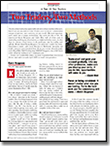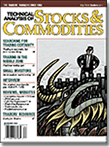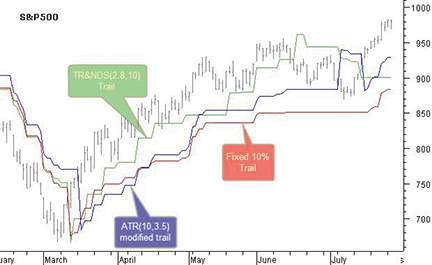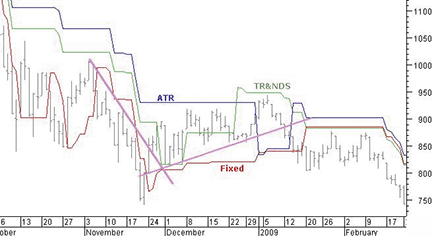Letters To The Editor
October 2009 Letters To The Editor
The editors of S&C invite readers to submit their opinions and information on subjects relating to technical analysis and this magazine. This column is our means of communication with our readers. Is there something you would like to know more (or less) about? Tell us about it. Without a source of new ideas and subjects coming from our readers, this magazine would not exist.
Address your correspondence to: Editor, Stocks & Commodities, 4757 California Ave. SW, Seattle, WA 98116-4499, or E-mail to editor@traders.com. All letters become the property of Technical Analysis, Inc. Letter-writers must include their full name and address for verification. Letters may be edited for length or clarity. The opinions expressed in this column do not necessarily represent those of the magazine. —Editor
TWO TRADERS, TWO METHODS
 Editor,
Editor,
Just wanted to comment on a very interesting interview you conducted with Gavin Mok and Kevin Haygreen (“Two Traders, Two Methods,” June 2009 S&C). I read many articles with trader profiles, and it is good to get insight from the traders who are just starting out or who are struggling to get to their desired level. Too many times, I find interviews to be about the lifestyles of the successful traders. But in reality, they are the exception, and only a small percentile of our peers are consistently profitable.
Once again, great job.
—Mike Toma
OPTION-TRADING SOFTWARE
 Editor,
Editor,
I read an article in your magazine titled “Selling Naked Options” (Working-Money.com, December 2006).
In it, the author discusses a company called the Naked Options Trading System headed by Vlad Korzinin, Ceo of MarketVolume.com.
I wanted to know if this service is still in operation and if its option-trading software is profitable.
—Maa
MarketVolume.com appears to still be in business, but as for whether their option program is profitable, it is best to ask those who have participated in the program. You might try checking user opinion on trader forums such as EliteTrader.com and others.
—Editor
TECHNICAL INDICATOR VALUE IN NUMERICAL FORM
Editor,
I have been trying to find software where I can see the technical indicator values in numerical form only. I have heard this is possible with Microsoft Excel, but I am not keen on using it since it requires a lot of manual input. Do you know of any alternatives?
—Yagnesh Patel
You can get data from sources such as Yahoo Finance that lists the data in numerical format. All you would have to do is transfer the data into an Excel spreadsheet.
—Editor
TRAILING STOPS
 Editor,
Editor,
I want to thank Sylvain Vervoort for his excellent work in his recent articles on trailing stops [“Using Initial And Trailing Stops” (part 1), May 2009; “Average True Range Trailing Stops” (part 2), June 2009; “Trailing Resistance &nd Support Stops” (part 3), July 2009].
I’ve tested his strategies under various market periods and have been impressed with the methodology. I was curious about his thoughts for improving performance in flat, nontrending markets. There seems to be a danger of getting whipsawed a bit. Has he looked at this type of market?
—Shane Merritt
Sylvain Vervoort replies:
When using the trailing stop method as a trading system, it will depend on which type of trailing stop you use to decide whether to trade automatically on the signal or have a good look at the chart first before making the trade.
If you are using the fixed-percentage stop, in my opinion, you would just trade it automatically. You just need to pick the right percentage value for the individual stocks based on recent history (a few years, looking at daily charts).
The same is applicable using the Atr trailing stop. Here also, you just need to pick the right multiplication value for the individual stocks based on recent history (a few years, looking at daily charts).
In both cases, I would assume you are trading for the medium to longer term — that is, a number of weeks to a number of months looking at daily charts.
It’s a different case when using the Tr&nds trailing stop. In the up move, this one is always going to be fast reacting. So you would use it if you are a swing trader. However, if you are a medium- to long-term trader, this kind of trailing stop will typically give intermediate sell signals that you would want to avoid, so you should seek out other technical analysis tools that would confirm the sell signal. (See my August 2009 article in S&C, “Trendline Tips And Tricks,” as a good starting point.)
You can compare the different trailing stops on a chart of the S&P 500 index in Figure 1. In an uptrend, the fastest and generally the most profitable of the three is the Tr&nds stop. The fixed-percentage stop will keep you in the trade as long as the maximum drawdown is not surpassed. The Atr stop may push you out of the trade if there is too much short-term volatility.

FIGURE 1: STOP METHOD COMPARISON. Here is a comparison of Sylvain Vervoort�s fixed-percentage stop, ATR stop, and tr&nds stop methods.
In Figure 2, the flat trading range, which occurred just prior to the time period seen in Figure 1, shows that the fixed percentage stop, using the same parameters, doesn’t work well. This is because price is making moves that are larger than 10%. The Atr is performing better with only one turning point, but the loss here (-10%) is rather large. Tr&nds is also making only one turning point, but the loss here is only about -2%.

FIGURE 2: TRADING RANGE MARKET. For use as a trading system, which stop method should be used on flat, nontrending markets?
If you compare this to the breaking of short-term trendlines with a loss of 0% with the wrong trade, it looks like Tr&nds comes closest to trendline trading. However, if you compare automatic trading on a number of stocks over a longer period using the three different trailing stop methods, the final profit is not that much different.
I would suggest using Tr&nds, but only trade if signals are confirmed by other technical analysis tools. In a trading market where price moves are limited over longer periods of time (very flat trendlines), you’ll find that, generally, chart patterns tend to be apparent.
HELP WITH SOFTWARE SELECTION
Editor,
Can you suggest any good yet affordable portfolio management software that you might know of or have tested for magazine? I have seen many products advertised, but I am lost as to what to select. Here is what I need it to do:
- Input client’s profile (conservative, aggressive, etc.)
- Multi and international asset class-compatible (bonds, fixed income, mutual funds, Etfs, US/European/world stocks, futures, commodities, forex, options, world indexes, benchmarks for comparisons)
- Online/offline data input (through a server or through popular data vendors like eSignal, Yahoo/Google finance, Bloomberg.com, etc.) as well as user-friendly import (that is, not having to import assets one by one and with not too much editing required) for instruments not included in auto import (used for Greek mutual funds, Greek stocks, etc. available through .txt, MetaStock, .csv, or from website tables with prices)
- Portfolio creation wizard (asset selections, allocations, etc.)
- Simulation on different portfolio structures, asset choices (Monte Carlo, etc.)
- Testing and optimizing of portfolio
- Rebalancing (modern portfolio theory, efficient frontier, etc.)
- Portfolio tracking (performance, PnL, cash inflows-outflows and necessary adjustments to perfor,mance data, etc.) for cash products (equity, etc.) as well as highly leveraged products (futures, forex, etc., used in short-term day trading and account a percentage of total portfolio).
- Comparing real, historical, and simulated performance scenarios for further improving portfolios.
- Reporting tool, client-friendly printouts (simple, medium, sophisticated levels)
—Alexios
Athens, Greece
We are not familiar with all the products available and all their features, but we suggest checking the Portfolio Management Software category of our Readers’ Choice Awards in our annual Bonus Issue for software that other readers tell us they are using and like, as well as checking the Traders’ Resource database at our website for software features. In addition, maybe someone reading this will offer a suggestion.
—Editor
ERRATA: AQR CAPITAL MANAGEMENT WEBSITE
On page 71 of the September 2009 Trade News & Products column, an incorrect website address was inadvertently given. The correct Url for Aqr Capital Management is www.aqrcapital.com. We regret this misprint
—Editor